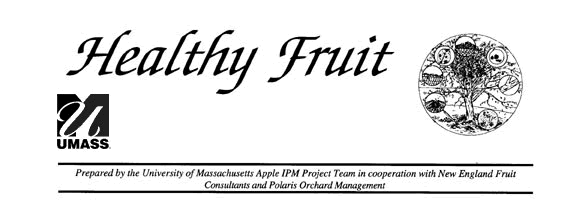
|
|
|---|
Given the light spring pressure from European red mites, coupled with poor soil and weather conditions for treatment, very few growers applied early_season miticides (Savey, Apollo, or Agri_Mek). Despite this fairly general lack of chemical treatments, the overall ERM population development has been minimal this season. However, a few orchards have begun to show signs of ERM population growth, and this is typically the time of year when relatively small populations can pick up steam. Growers may find this a good time to assess the ERM situation and consider strategies for treatment of the developing summer population.
For sampling in early to mid_July, we recommend that treatment be considered if 65% or more of middle_aged leaves (sampled throughout the canopy) are infested with 1 or more motile mites. If treatment is necessary, there are four chemicals labeled for summer use: Pyramite, Apollo, Vendex, and Kelthane—Pyramite and Apollo (which requires a 45_day preharvest interval) stand as the most highly recommended rescue materials. Recent comparisons in New York and North Carolina have shown Pyramite to be an effective summer ERM treatment, though this material is known to be less effective against two_spotted spider mites. For a deeper review of these materials against both ERM and TSM, refer to the 2000 March Message.
Any way you slice it, management of resistance development should always be a consideration, as mites are notorious for their ability to build up resistance to materials used consistently over the course of only a few years.
Accumulation of apple maggot flies on unbaited monitoring spheres is progressing very slowly—statewide, captures remain far below 1 AMF per trap, and no blocks have exceeded treatment thresholds. Logically, we anticipate that captures of AMF will build from here on, and some early cultivars may enter the risk window for early_season AMF injury in a week or so. When trap captures exceed 2 AMF per sphere, growers should consider a treatment with a low rate of Guthion or Imidan, particularly on susceptible early cultivars such as Gravenstein, Early Mac, and Jersey Mac.
Thanks to all the growers who responded with potential sites for testing of sphere/odor traps on Red Astrachan.
Potato leafhoppers (PLH) are prevalent in many Massachusetts orchards as of early July. Evidence of their injury is significant on foliage in young, unsprayed trees, as noted by yellowing margins and curled leaves of shoot growth. In general, they are of no concern in mature orchards, but we get pretty excited when we see them in young trees because they stunt new terminal growth. PLH has also been implicated in fire blight spread too, so this year in particular would be a good year to keep them in check. The recommendation is to treat young blocks with an effective insecticide -- Imidan, Guthion, Sevin, Thiodan, or Provado all work -- as soon as PLH or their injury are evident. Thidoan or Provado have more residual activity, and are probably the best choice. Again, it is generally not necessary to treat older trees, but scout your young plantings for evidence of PLH and treat as necessary. It has been widely observed that 'Honeycrisp' foliage exhibits yellowing of leaf margins similar to PLH injury. At first it was believed this was indeed PLH injury, but now it is thought that the yellowing is an inherent characteristic of the cultivar. Therefore, scout your 'Honeycrisp' blocks for actual signs of PLH adults or nymphs before treating.
According to a report by the Canadian Food Inspection Agency (CIFA), plum pox virus (PPV) has been found in a block of Fantasia nectarines in Niagara, Ontario, Canada. The origin of the infected trees is Adams County Nursery in Pennsylvania, where PPV was first detected in North America last fall. As you are probably aware, a comprehensive survey of stone fruit throughout North America for PPV is being coordinated by USDA and CIFA this growing season, with the goal of confirming or denying the spread of PPV outside of Adams County Pennsylvania. PPV is a serious viral disease (with no cure) of commercially important peaches, nectarines, and plums. Hence, the ambitious effort to determine the extent of its existence in North America is underway. UMass Extension IPM Specialist Craig Hollingsworth reports that the PPV survey in Massachusetts was complete as of July 6. UMass, Massachusetts Department of Food and Agriculture, USDA, and Polaris Orchard Management combined forces to sample peaches at 31 locations in ten Massachusetts counties for a total of 322 samples. Craig says all samples have been analyzed for PPV and all were negative for the virus. This is good news, however, we await result from the rest of the Country to establish PPV's presence or absence elsewhere. (See: www.umass.edu/fruitadvisor//Team_members/clements/plumpoxsurvey.html for more details on the PPV survey in Massachusetts, or the official PPV web site.)
Healthy Fruit is written by Dan Cooley, Ron Prokopy, Jon Clements, Starker Wright, Arthur Tuttle, Wes Autio, Bill Coli, and Duane Greene except where other contributors are noted. Publication is funded in part by the UMass Extension Agroecology Program, grower subscriptions, and the University of Massachusetts IPM Program. A text version can be e-mailed to you if you contact Doreen York. Please cite this source if reprinting information.
Go to the UMass Extension Main Page
Return to the UMass Fruit Advisor Main Page
Return to the Healthy Fruit Index Page